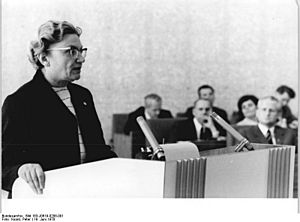Lieselott Herforth facts for kids
Lieselott Herforth (born September 13, 1916, died November 30, 2010) was an important German scientist and politician. She was a physicist, which means she studied how the world works at a very basic level. She also served in the government of East Germany. What makes her truly special is that she was the very first woman to become the head (called a rector) of a university in Germany!
Contents
Early Life and Studies
Lieselott Herforth was born in 1916 in a town called Altenburg. Her father was a writer and publisher. She finished high school in Berlin in 1936.
After high school, she went to the Technical University of Berlin. There, she studied physics and mathematics. In 1938, she started working as an assistant for these subjects. She earned her diploma in 1940. Her research for her diploma was guided by a famous scientist named Hans Geiger.
Later, in 1943, she worked at places like the Kaiser Wilhelm Institute for Physics in Berlin and the University of Leipzig. In 1946, she worked as a physicist in Berlin. She continued her studies and earned her doctorate degree in 1948. This was a very high academic achievement.
In 1953, she completed another important academic step called a "habilitation." This allowed her to teach as a professor. Her research for this focused on how fluorescence (a type of light) could be used in medicine. She was one of the first women in Germany to achieve this in physics, a field mostly studied by men at the time.
A Career in Science and Education
After her habilitation, Lieselott Herforth became a lecturer at the University of Leipzig. She taught about radiation physics. From 1955 to 1960, she was a researcher at the Institute for Applied Radioactivity in Leipzig.
She also taught as a professor at the Technical University of Leuna-Merseburg. In 1960, she moved to the TU Dresden. There, she became a professor, teaching about how to use radioactive isotopes. These are special forms of elements that can be used in many ways, like in medicine or industry. She also became the director of an institute at the university that focused on using these isotopes.
Leading a University
From 1965 to 1968, Lieselott Herforth made history. She became the rector of the TU Dresden. This meant she was the head of the entire university. She was the very first woman in Germany to hold such a high position at a university. This was a huge step for women in science and education.
After her time as rector, she continued to teach. From 1969 to 1977, she was a full professor of experimental physics at the TU Dresden. She taught about radioactivity and dosimetry, which is the science of measuring radiation.
Her Role in Politics
Besides her amazing work in science, Lieselott Herforth was also involved in politics. From 1963 to 1981, she was a member of the People’s Chamber. This was like the parliament or main law-making body of East Germany. She represented a group called the Freien Deutschen Gewerkschaftsbunds.
During the same time, she was also a member of the State Council of East Germany. This was a powerful group in the government of East Germany. She was a member of the SED, the main political party. In 1966, she also joined the University Council of the Ministry of Higher Education. This group helped guide universities.
Awards and Honors
Lieselott Herforth received many awards for her important work.
- In 1969, she became a full member of the German Academy of Sciences at Berlin. This is a very respected group of top scientists.
- In 1971, she won the National Prize of the German Democratic Republic for science and technology. This was one of the highest awards in East Germany.
- She received an honorary doctorate from a university in Hungary in 1974.
- In 1977, she was given the Humboldt Medal in Gold.
- In 1982, the TU Dresden made her an Honorary Senator.
- She also received several important national awards from East Germany, including the Patriotic Order of Merit in Silver (1964) and Gold (1981), the Banner of Labor (1966), and the Distinguished Service Medal of the National People's Army in Gold.
- She was recognized twice as an "activist" and a member of the "Kollektiv der sozialistischen Arbeit," which honored groups of workers for their achievements.


